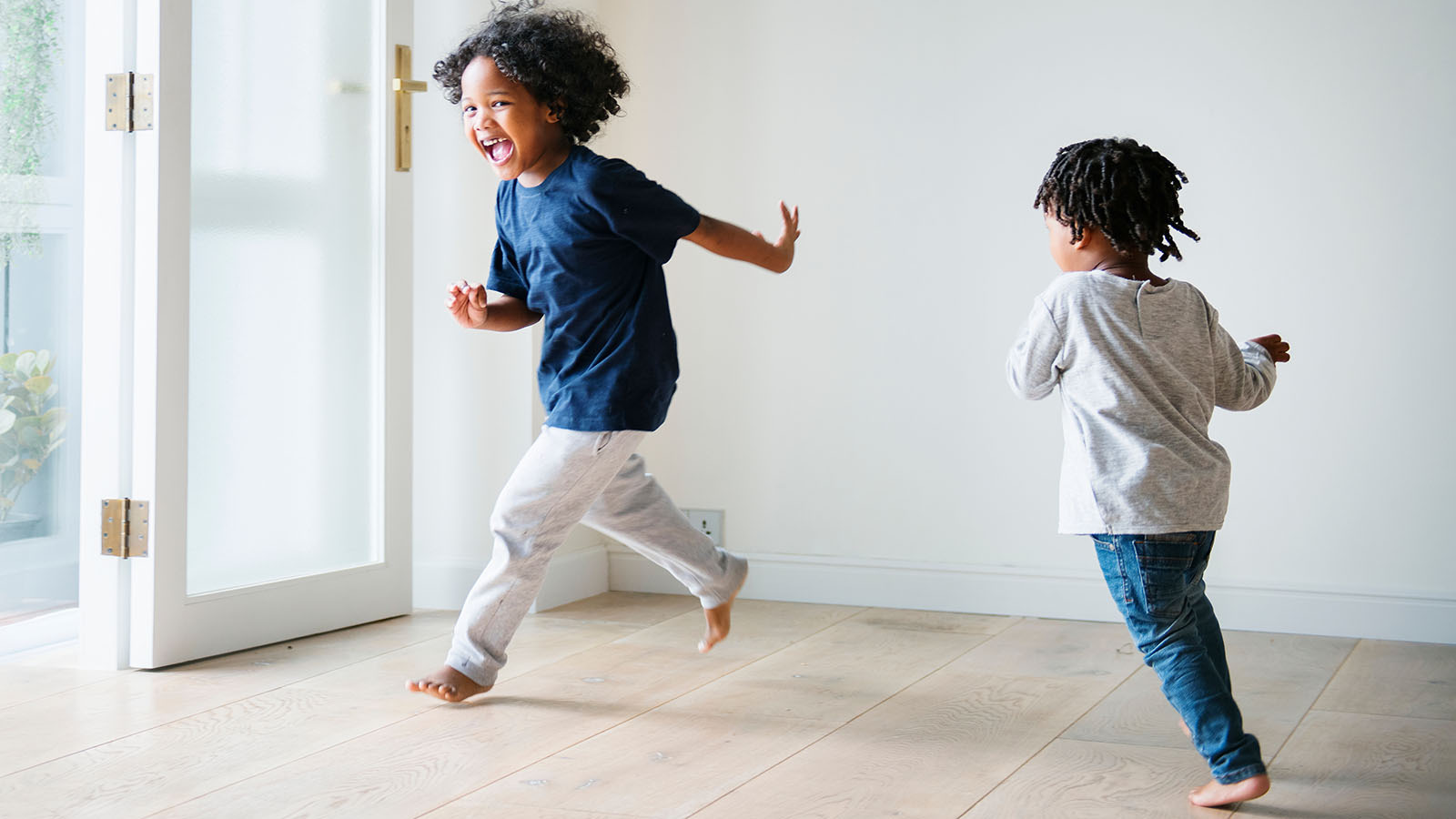By Sandy Damashek
Summer has arrived, and if you think this year feels different from others, we agree. COVID-19 has changed the rules and children (and parents) are on the lookout for fun things to do at home. Look no further, we’re here to help. We’ve got two great ideas to keep your 3-6 year old happy, busy, and learning all summer!
If your child is a budding artist, you might start with Shape Surprises. Spotting shapes at home leads to drawing shapes and then, to transforming them into creative and colorful bugs and flowers. With your help, your child can become a shape, color, and counting pro!
Or, if you’re lucky enough to have a backyard, head straight for The Big Runaround and create your own outdoor obstacle course. No backyard? Bring the outside inside by building a Runaround course in your living room or child’s bedroom. Either way, it’s time for you and your child to get physical!
Both activities have been designed to blend play and learning — illustrating concepts of size, shape, counting, and color. Check out our Parent Tips for age-appropriate prompts to help your child explore. If you have a preschooler, start simple. If there’s a first grader in the house, extend the play by adding challenges – and more complex learning concepts.
Do the activities in any order. Feel free to change them. Make pictures with multiple shapes or create new challenges for your obstacle course. Think playtime, not school-time!
Shape Surprises!
(Shapes, colors, counting, size relationships, living things)
Shapes are everywhere! Help your child discover shapes at home (or outside) and turn hand-drawn shapes into beautiful blooms and/or big-eyed bugs!
What You’ll Need: Drawing tools (crayons, markers, or paint & brushes), large pieces of paper (drawing pad, poster board, construction paper, paper bag, etc.), tape, newspaper or wipe-off tablecloth to protect the art area.
How To Prepare: Cover your art area with newspaper or a wipe-off tablecloth. Lay out a piece of paper for your child (and one for you, if you’d like). Tape the edges to hold the paper in place.
What to Do:
- Ask your child to find circles in your home (or outdoors), and use his/her finger to trace each circle you find.
Parent Tips (Shapes):
- For younger children, start the shape hunt by pointing out a few circles (wheels on toys, door knobs, dishes, pot lids, etc.). Then ask your child to find more circles.
- For older children, follow the above tip if necessary. Extend the math by asking: What is the same about all of these circles? (The rounded shape) Do the circles have any straight lines? (No)
- Challenge your child to draw or paint his/her own circles on the paper. If you’d like, make a picture together. Take turns adding circles! Start with a few big circles. Add some small circles. Make a small circle inside a bigger circle and a big circle around a smaller one.
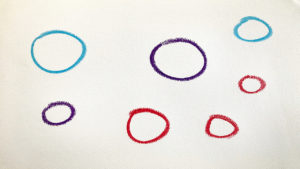
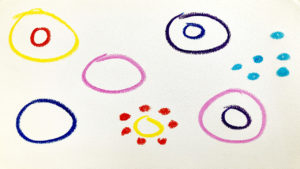
Parent Tips
- (Size Relationships, Counting) Point to a big circle and a small circle. Ask: “Which circle is bigger? Which is smaller?” Then, have your child point to the big circles and count them one by one. Point and count along if your child needs help. Do the same for the small
- It’s time for the shape surprise – learning how to turn circles into bugs or flowers! Your child can make a mix of both – or choose either one! To make a circle bug, add eyes, a mouth, legs, wings, and antennae; to make flowers add a stem, leaves, and petals.
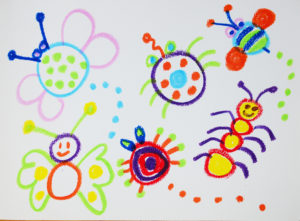
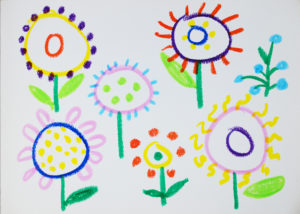
Parent Tips (Living Things)
- Show children the bug and flower pictures on this page. Point out the different parts. Older children may be able to identify some parts. If your child needs help, have him/her repeat the part names after you.
- Guide younger children by having them draw each part as they name it. Let older children add the parts in any order.
PHYSICAL ACTIVITY
The Big Runaround! (Movement, Motor Skills, Counting, Sequencing)
Most children have endless energy. They love to run, jump, climb, throw, and move their bodies in many different ways. The Big Runaround helps children do just that! Using found objects from around the house, you and your child can create your very own obstacle course (outside or inside). It’s easy and fun, and the details are up to you!
What You’ll Need: Objects from your house or yard, a timer (optional)
How To Prepare: Gather some objects together. You can use almost any objects to create physical challenges, e.g., bowls, pots, spoons, ladles, baskets, chairs, cereal boxes, cups, plates, books, balls of yarn, building blocks, cardboard tubes, toys, sticks, stones, etc.
What to Do:
- Build your obstacle course by setting up “physical challenge stations” around the yard or in your house. Encourage your child to suggest ideas and help you build. Here are some possibilities:
- Toss 1-2 sock balls into a basket/cardboard box.
- Jump over a pillow or plush toy 3 times
- Jump up and down 10 times
- Blow a whistle/quack 4 times
- Stack 5 blocks or rocks (in any order) to make a tower.
- Stack 4 dishes (alternating cup/plate/cup/plate).
- Balance a book on your head and turn around 3 times.
- Balance a ball on top of a paper tube and walk around a chair.
- Pick up 4 sticks/pipe cleaners by jumping from one to the next, then use them to make a square shape.
- Run a zigzag path around tin cans or plastic bottles (without knocking any down).
Parent Tips (Creating Challenge Stations)
- You know your child best. Create activities that match your child’s age and abilities. For younger children and those with less developed motor skills, start with easier challenges. Then build up to harder ones. For more athletic children, create more difficult or more complex challenges.
- Vary the physical tasks so your child can explore different movements and skills. For example, running and jumping focus on lower body movement, while balancing a book and stacking blocks require upper body and small hand coordination.
- Challenge your child to go through the course, doing each physical task along the way.
Parent Tips (Movement/Motor Skills)
- For younger children especially, start by modeling each move. Describe each action as you do it. Then have your child try while you give guidance.
- If your child has trouble, simplify the challenge, e.g., move the basket closer, build with fewer blocks, carry a ball in a bowl instead of balancing it, etc.
- Keep playing! Change up the course. Reverse the order of the obstacles. Add new obstacles. Time each run to add to the fun. The possibilities are endless!
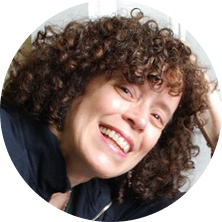
Sandy Damashek has been crafting children’s educational media for many years. She began her career at Children’s Television Workshop where she developed Sesame Street toys and games and helped launch CTW’s Interactive Group and Sesame Place. Sandy’s experience includes creating interactive movies and television, museum exhibits, children’s books, and countless playthings. Sandy has a Master’s Degree in education from Harvard University.

